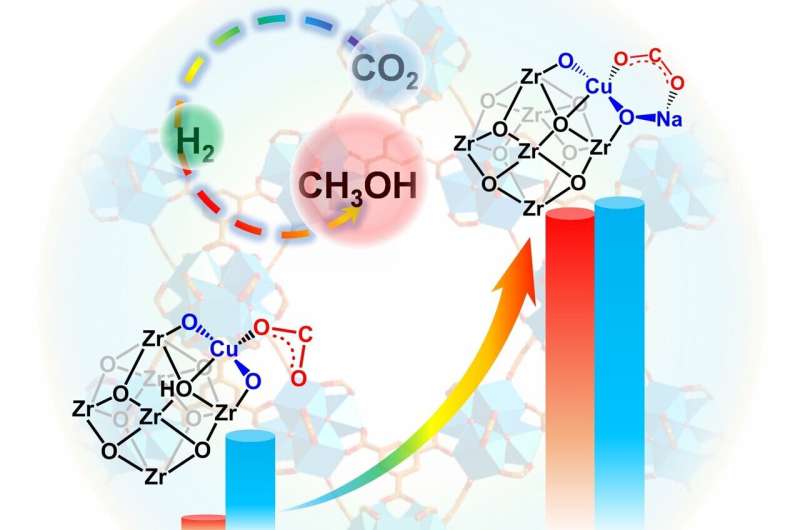This article has been reviewed according to Science X's editorial process and policies. Editors have highlighted the following attributes while ensuring the content's credibility:
fact-checked
trusted source
proofread
Alkali-decorated microenvironments aid Cu single atom catalysts in CO₂ hydrogenation

Since the advent of industrial revolution, the accumulation of carbon dioxide (CO2) in the Earth's atmosphere has raised significant environmental and climate concerns. As a response to this pressing challenge, the conversion of CO2 into chemicals and/or fuels through direct hydrogenation has emerged as a widely recognized and imperative strategy for mitigating both CO2 emissions and fossil fuel consumption.
Among the array of catalysts investigated for CO2 hydrogenation, copper (Cu)-based catalysts have garnered increasing attention for their promising potential in the production of methanol. However, despite the promising catalytic activity exhibited by Cu-based catalysts, their practical application in CO2 hydrogenation faces a significant difficulty arising from the intrinsic reduction and aggregation tendencies of the Cu-based active centers, particularly at the elevated operating temperatures.
This propensity for reduction and aggregation could potentially result in larger Cu particles, consequently diminishing the CO2 hydrogenation activity and leading to the generation of undesired CO byproducts. As a result, this pose a considerable impediment to simultaneously achieving the desired high catalytic activity and methanol selectivity, which are beneficial for large-scale industrial applications.
To address these challenges, the research team led by Professor Hai-Long Jiang from the University of Science and Technology of China (USTC) has proposed a novel strategy aimed at immobilizing and stabilizing single-atom Cu sites within a metal-organic framework-based catalyst by creating the Na+ decorated microenvironment in close proximity. The work is published in the journal National Science Review.
Through comprehensive experimental and theoretical calculation investigations, they have uncovered the importance of Na+-decorated microenvironment around the single-atom Cu sites. This microenvironment plays a crucial role in maintaining the atomic dispersion of Cu sites during the CO2 hydrogenation process, even at high temperatures reaching up to 275°C, through the electrostatic interaction between Na+ and Hδ- species.
This exceptional stabilization effect of single-atom Cu sites has endowed the catalyst with excellent CO2 hydrogenation activity (306 g·kgcat-1·h-1), high selectivity to methanol (93%), and long-term stability, far surpassing its counterpart lacking the presence of Na+.
This work not only advances the development of Cu-based catalysts for selective CO2 hydrogenation to methanol, but also introduces an effective strategy for fabricating stable single-atom sites in advanced catalysis by creating alkali-decorated microenvironments in close proximity.
More information: Li-Li Ling et al, Promoted hydrogenation of CO2 to methanol over single-atom Cu sites with Na+ decorated microenvironment, National Science Review (2024). DOI: 10.1093/nsr/nwae114
Provided by Science China Press



















